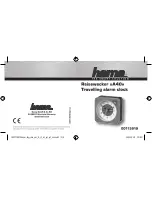
5
2.1 Important Safety Instructions
WARNING: Mains operated Alarms
must be installed
and interconnected by a qualified electrician in
accordance with the local appropriate Regulations
for Electrical Installations. Failure to install this Alarm
correctly may expose the user to shock or fire hazards
and damage the product.
The Alarm is designed to be permanently mounted,
using its own built-in terminal block to connect it to the
mains. The mounting plate can be screwed directly to
the ceiling. Alternatively, it can be screwed to a standard
junction box (BS 4662 single gang accessory box). The
Alarm must not be exposed to dripping or splashing.
There are important markings on the underside of the
Alarm.
WARNING:
An all-pole mains switch shall be
incorporated in the electrical installation of the building.
WARNING:
Batteries (battery pack or batteries
installed) shall not be exposed to excessive heat such
as sunshine, fire or the like.
ATTENTION:
Alternative Energy Sources - (Wind,
Solar, UPS etc.)
This product is designed to be connected to a Pure or
True Sine Wave 230V AC supply.
If connecting to a power source that utilises an inverter,
e.g. PV solar panel, the Total Harmonic Distortion (THD)
must be less than 5%. If in doubt, please check with the
manufacturer of the inverter. This also applies to battery
powered UPS (Uninterruptible Power Supply) inverters.
ATTENTION:
Light Dimmer Circuits – The Alarms must
not be powered from a light dimmer circuit.
ATTENTION:
Do not
install Alarms in new or renovated
buildings until all work is completed.
ATTENTION:
The Alarm must
not
be connected when
the house wiring insulation is being checked with high
voltages. i.e. Do
not
use a high voltage insulation tester
on the Alarm.
ATTENTION:
The Alarm must be continuously powered
24 hours a day so it is important that it is not on a circuit
that can be turned off by a switch.
ATTENTION:
(UK)
BS 5839-6:2019 gives the following
recommendations regarding the mains supply to be
used in a Grade D system. The power supply for the
Alarms should be derived from the public electricity
supply to the dwelling. The mains supply to the Alarms
should take the form of either:
(a) an independent circuit at the dwelling’s main distribution
board, in which case no other electrical equipment
2. Installation






































